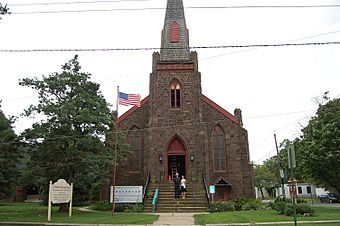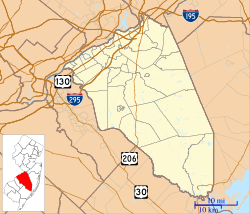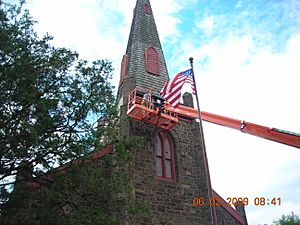St. Stephen's Episcopal Church (Beverly, New Jersey) facts for kids
Quick facts for kids |
|
|
St. Stephen's Episcopal Church
|
|
 |
|
| Location | 158 Warren Street, Beverly, New Jersey |
|---|---|
| Area | 2.3 acres (0.93 ha) |
| Built | 1853-1855 |
| Architect | Thomas Harris; Frazer, Furness and Hewitt |
| Architectural style | Gothic Revival |
| NRHP reference No. | 99001363 |
| Added to NRHP | November 25, 1999 |
St. Stephen's Episcopal Church is a historic church located in Beverly, New Jersey. It stands at the corner of Warren and Wilmerton streets. People started worshipping here in 1837. The church building you see today was officially opened in 1855. The current leader of the church is Fr. Robert Legnani.
Contents
The Church's Beginning and Building
The St. Stephen's Episcopal Church community started in 1837. Forty-four families asked Bishop Doane for a church in Beverly. Their first church was a white wooden building on Copper Street. It had a cemetery next to it, which is still there today. When Beverly became a city in 1857, St. Stephen's was its very first church.
By 1853, the church community had grown too big for the old wooden building. So, they bought land at Warren and Wilmerton Streets for a new church. This new spot allowed them to build a much larger and more detailed church. Being on Warren Street, a main road, also made the church more noticeable. The church's tall steeple was a helpful landmark for boats on the Delaware River. On October 1, 1855, the new St. Stephen's Church was officially opened. Bishop George W. Doane led the ceremony.
Early Design and Architecture
St. Stephen's Church was built between 1853 and 1855. Its design shows a time when people wanted to bring back the style of old English Gothic churches. They aimed to create a worship space that felt spiritual and also looked well-designed. This meant using specific shapes, materials, and layouts.
The idea of returning to the English Gothic style became popular in the 1830s in England. It was very popular in America when St. Stephen's was built. This movement wanted churches to have a clear and consistent look. They believed that churches should always look formal and proper.
The main ideas for this church style, which you can see in St. Stephen's, were:
- A simple layout
- Basic building materials
- Decorations that fit the church's simple look
The inside of the church is quite simple. It has a main area called the nave, where people sit in pews. Then there's the chancel, which is where the altar and choir are. Ideally, these churches were built from stone. However, wood was used if stone was too expensive. The decorations at St. Stephen's are simple but elegant. They show the careful style that designers used to create a medieval feel. They believed this style was the most spiritually true for a place of worship.
Many things have changed outside St. Stephen's Church since it was built. But the inside of the church looks much like it did for over 130 years. When you look from the entrance, you can see through the nave to the altar. The ceiling has a special roof support system that looks like the inside of a ship. These large wooden beams seem very strong. However, the main support beams are actually hidden under the ceiling plaster.
Beautiful Stained Glass Windows
St. Stephen's Church has a wonderful collection of stained glass windows. They show different styles from the 1850s up to the early 20th century. Generally, the oldest windows are near the altar, and the newest ones are near the entrance. You can see windows with textured glass from the mid-1800s. There are also works by J.R. Lamb, who was a competitor of the famous Tiffany Glass studios. Some newer windows from the 1970s and 80s were made by artist F. Paul Skelly.
Saving the Church: Preservation Efforts
The St. Stephen's community worked hard to preserve their church. With help from an architectural firm, they spent seven years getting grants. These grants helped them plan the preservation, study the building, and finally start construction.
A company called Wu & Associates, Inc. was chosen to do the preservation work. They focused on restoring the church's steeple, which was its "beacon" feature. In 1983, lightning struck the steeple, burning away two-thirds of it. A lightning rod fixed the immediate problem. However, the new cedar roof shingles kept getting damaged by local wildlife.
To keep the church's original look, the community and construction team researched its history. Old photos and a postcard from 1909 showed the steeple looking dark, like the roof. This suggested the original roof might have been slate. So, they decided to use slate for the new roof.
Now, steel beams support the steeple. These beams are anchored into the stone walls of the tower. This is much stronger than the old 150-year-old wooden beams. Other improvements included new flooring, fresh paint colors that matched the original ones, a cleaned church bell, and a repaired stained glass window in the tower.
The stained glass windows and woodwork inside the church are very detailed. But the work done by Wu & Associates to make the building strong and keep its simple design was very important. It helped save the church's architectural history and its special place in Beverly.
The money for the project came from grants. But church members also helped, like the children who raised over $4,000 with their "Mile of Nickels" campaign. Businesses and other people in the town also contributed.





